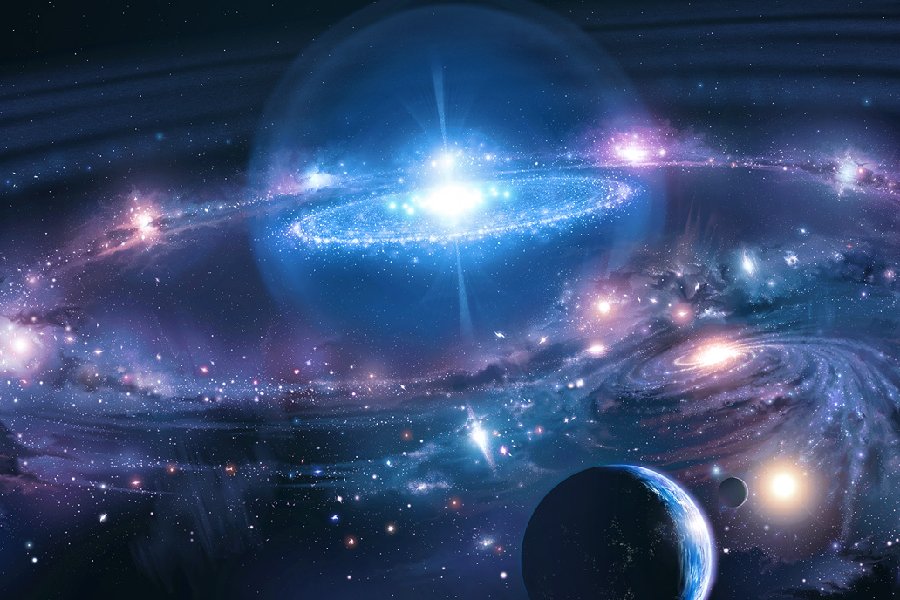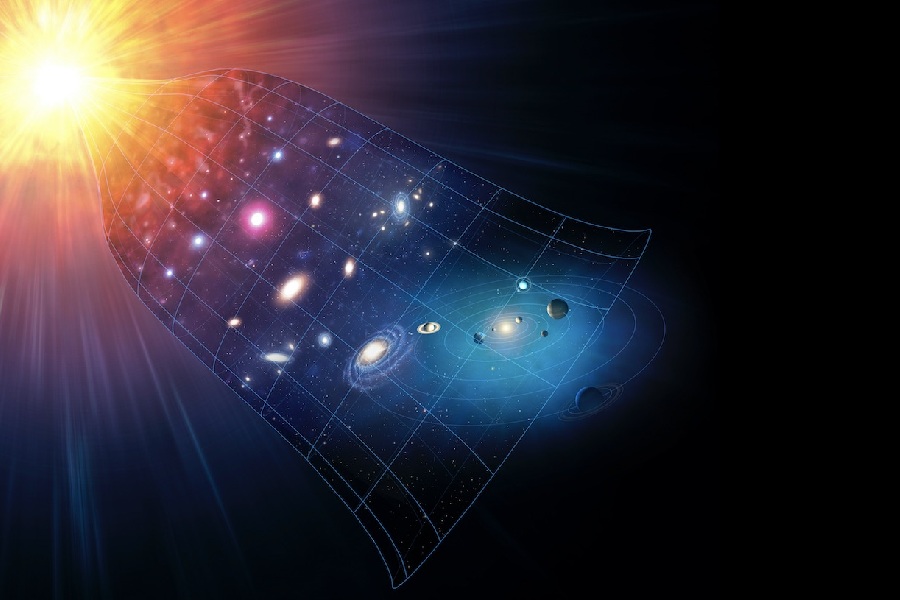Stars appear as mere specks in the night sky, belying their actual huge dimensions and radiance. This same difficulty arises when we aim to gauge the size of our universe through mere observation. How big is the universe?
From Earth, space seems infinitely vast. Yet astronomers can now estimate its scale. They use clever techniques and powerful telescopes to map observable boundaries. So, is the universe infinite?
In this article, we will explore competing ideas around the overall shape and size of space itself. These range from closed spherical containers to endless expansion, perhaps powered by mysterious dark energy.
Evaluating perspectives provides insight into existential riddles concerning cosmic origins and destinies. While the full extent remains ambiguous as cosmological knowledge frontiers shift, one truth shines – the measured portion far exceeds what past generations envisioned.
Analyzing the challenge of quantifying the universe’s unfathomable enormity will crystallize how far science has pressed toward determining just how big it stretches.

How Big Is the Universe?
How big is the universe? The size of the universe is mind-bogglingly vast. It includes everything: galaxies, stars, planets, and more. Scientists measure its size in terms of how long it takes for light to travel, and that’s called a light-year.
The observable universe, the part we can see, is about 93 billion light-years across. However, the entire universe could be much larger, extending beyond what we can currently observe.
The Vastness of the Universe
What is the observable universe?
The observable universe is the area around Earth that we can see. It includes all places close enough for light signals to reach us. This depends on how fast space has expanded since the hot, dense beginning after the Big Bang.
Beyond a horizon sphere, space grew too quickly for light to get to us. This horizon marks the edge of what telescopes can observe. What we see is a tiny part of the likely grand scale.
Faint signals from beyond the horizon blend with leftover microwave glows filling space. This cosmic microwave background was released around 380,000 years after the Big Bang as the universe cooled and became transparent. So, how big is the observable universe?
Expansion effects on observable domains
Our cosmic horizon currently sits 46 billion lightyears out in all directions – defining the radius of what’s observable. But the visible universe was much smaller early on. Extrapolating using expansion rates, the whole observable universe emerged from a tiny patch 13.8 billion years ago.
Detecting light across almost the entire history gives crucial clues about evolution and particle origins. Many questions remain on realms eternally beyond observation.
Infrared glows potentially contain combined emissions from ancient stars residing outside the observable boundaries though evidence stays confined to a shrinking visible portion as cosmic expansion stretches on.
Connecting to cosmic horizons
The cosmic horizon marks where space has stretched so much that even early galaxies’ light cannot reach us. This horizon divides space into parts we can observe versus other parts permanently estranged by accelerating expansion.
What we can observe has deep implications for reconstructing the history of the cosmos after the Big Bang. Noticing patterns in uniformity and geometry reveals physics from the universe’s mysterious early eras. The horizon shells off domains with exclusively different futures based on structure lifecycles.
Outer galaxies formed billions of years ago now sit beyond border detection limits. Their emitted light never bridges the void separating local clusters. Calculating trajectories shows growth rates for the disconnected realms concealed past the horizon.
These unseen regions now exceed 110 billion lightyear radii, gaining speed. Small early irregularities hint at initial quantum fluctuations that decide destinies between inclusion or terminal disconnection.
Precision measurements even constrain expectations of partner spheres mirroring our own but fully cloaked by obscuring aftermath emissions just 380,000 years after the Big Bang.
How far can we see into the universe?
Currently, our techniques allow seeing back to about 400,000 years after the Big Bang. That was when the newborn universe had finally cooled enough for light to travel freely through space. A fundamental question surrounding these observable horizons involves just how much of the universe is observable with current and future tools.
We see those earliest detectable objects as they were long ago. But now, accounting for expansion over 13.8 billion years, they are an estimated 46 billion lightyears away from us. Future tools may expand observations even closer to the universe’s inflation epoch right after the Big Bang.
Astronomers use specialized telescopes to gather cosmic signals spanning the electromagnetic spectrum, from long radio wavelengths to short, energetic gamma rays. They point these ground and space telescopes toward galaxies, quasars, pulsars and more across deep space.
By analyzing certain measurable properties like the reddening of light or brightness patterns, astronomers can estimate distances to objects seen far across intergalactic spans of both space and deep cosmic time.
The specific technique depends on the target and wavelength observed. But measurable redshifts and luminosities ultimately allow mapping extremely remote objects back to earlier eras soon after the universe first lit up.
Cosmic microwave background
The cosmic microwave background signifies the afterglow of cooled photons released around 380,000 years post Big Bang when atoms initially formed, rendering space transparent. Variations expose conditions molding large structures seen later.
Detailed measurements like WMAP and Planck satellites reveal slight mottling in the microwave background. This traces the seeds differentiating modern galaxy clusters, voids, and superclusters, indirectly reflecting primordial epochs guiding the resulting cosmos.
What is beyond our observable horizon?
The unimaginably vast unseen portion beyond detection continues interacting independently. With unknown but hopefully similar physics, we can only speculate on dimensions and traits in these estranged expanding sectors devoid of signals.
If matching observable areas, the obscured majority stretches orders of magnitude wider still, forever eluding visibility. Contemplations of what is beyond the universe both tantalize and humble understanding.
Fundamental limits to knowledge
Due to ongoing cosmic acceleration, light or information can never reach us from beyond the observable universe’s distant “cosmic horizon” cutoff. This creates an impenetrable veil blocking any verification of theories about the unknown realm’s actual contents or laws.
Our empirical methods and tools face definite limits in substantiating the ultimate extent of existence. As remote galaxies accelerate from view past observing limits, this reality beckons metaphysical musings on realities far exceeding perception’s scope.
Essentially, advancing cosmic motion blankets incredibly remote space behind a veil of oblivion to observation from Earth’s vantage. We can only philosophically ponder what unseen cosmic physics, exotic particles, strange dimensions or alien realms may operate past our detectable cosmic confines.
Profound questions emerge on whether familiar principles could operate at unlimited distances or shift into other unfamiliar phases.

What Is the Speed of Light?
The speed of light in vacuum equals approximately 300,000 kilometers per second or 186,000 miles per second. This velocity proves constant regardless of a light source’s motion or frame of reference for any inertial observer across space-time.
Light’s stable reliable velocity enables measuring gigantic interstellar and intergalactic separations. This is done through timing signals’ journeys spanning human and geological eras. Added velocities from cosmic expansion introduce uncertainties when projecting back birthdates.
However, astronomers account for effects by applying calibrated cosmological redshifting ratios for adjusted dating mapped against detection intervals though relativity forbids accelerating to light speed.
Some quantum entanglement phenomena can convey linkage states faster than light limitations impose on ordinary transport across divides. This constancy of light speed persists as a pivotal cosmos feature enabling calibrated mapping and comprehension.
Crucial role in astronomy and cosmic distances
Light travels at a stable, unchanging speed through the vacuum of space. This reliable velocity of light enables measuring incredibly vast distances between stars, galaxies and other objects across the cosmos.
Scientists can time long journeys of light signals and photons spanning thousands or even billions of years. By knowing the travel duration and knowing the consistent speed that light always travels at, astronomers can then calculate gigantic lengths between separated celestial bodies across interstellar and intergalactic space.
Connecting space and time
Einstein realized the consistent speed of light means nothing can exceed this cosmic speed limit. As objects approach light speed, their mass escalates toward infinity, preventing further acceleration. This time dilation effect binds faster travel, linking space and time.
Since light has a finite velocity, observing far celestial occurrences peers back in time. Distant quasars or galaxies look younger because their photons take billions of years to traverse expanding space before detection. Thereby astronomy interlaces, looking deeper outward with looking further back on time’s arrow.
How does the speed of light affect our view of the universe
Impact on observations
Light’s speed is restricted. So we see distant past events delayed. Signals take time reaching Earth through expanding space. Meanwhile, relative motions add uncertainty around locations and movements.
It takes over 13 billion years for photons from near the Big Bang to get here. Seeing such early cosmic times means looking 97% back into the past. But those first objects probably changed a lot since emitting the light detected now, the long waits to see antiquated glimpses hinder understanding processes behind modern cosmic features in real time.
Illusion of present reality
What telescopes receive corresponds less to current actuality the more ancient and distant. As gravity continually reshapes contents over such vast eras, early emissions represent stale outdated views. No synchronized real-time snapshot can fully capture an accurate present universe.
Untangling complex life cycles and histories of remote galaxies requires accounting for the huge separation between past signal sending and modern derived orientation – a formidable barrier. Adjusting for associated drifts altering geometries involves intricate calculations to reconstruct spatial chronology correctly.
What Is the Expansion Rate of the Universe?
Expansion concepts
The Hubble constant measures the current galaxy’s recession rate across stretching space since the Big Bang. This critical expansion velocity sets overall universal dimensions and governs fate models around density and geometry. Slower expansion may recollapse, while faster could rip components apart.
Quantifying enlargement rates allows dating cosmic events, tracing stellar life cycles. And weighing predictions of open, closed or flat space futures dependent on acceleration. Determining the mechanisms and history of expansion uncovers clues behind the increasing rate and properties of the mysterious dark energy substratum.
Tracking expansion over eras
Early inconsistent Hubble values plagued cosmologists. Converging late 1990s observations determined a 72 km/s galaxy separation rate per megaparsec amidst local markers. Precision continues improving through satellites and next-generation spectrographic surveys scanning wider volumes.
Unexpected accelerating expansion signaled dark energy domination, portending eternal structural dilution as galaxies mutually receded from observation.
But questions remain whether acceleration simply marks a temporary phase that will shift again over deeper time. Many hypothesize preceding deceleration when high accumulated matter gravity reigned prior to transitional epochs.
Conclusion
How big is the universe? Focusing on the elusive expanse of our universe, we covered vast stretches and cosmic horizons that define science’s present view containing numerous galactic clusters.
We surveyed measurement techniques that determine the observable sphere’s 93 billion lightyear diameter. We also glimpsed boundaries beyond which untold immensity surely continues expanding, only indirectly hinted through background temperature profiles.
As cosmic knowledge expands our understanding of the universe’s size, astronomers progressively reveal the immense grandeur stemming from microscopic origins that ballooned bigger than human intuition can fathom.
We hope touring these widening vistas sparks existential and philosophical contemplation regarding life’s purpose amidst surrounding grandeur, and how even bounded domains prove massive for passion and potential.
